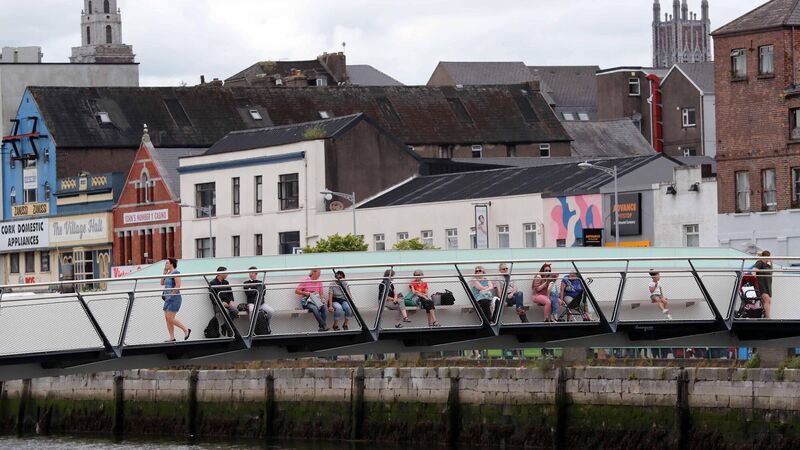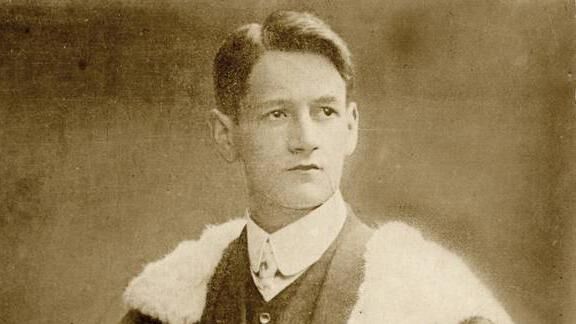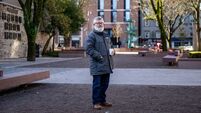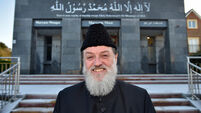Michael Moynihan: Cork has its own unique history when it comes to naming places

Mary Elmes Bridge. Picture: Jim Coughlan.
During the week I had reason to get into town — these runners won’t replace themselves — and on the stroll around I ventured somewhere I haven’t been before.
I crossed the Mary Elmes Bridge, admiring the view up and down the river it affords, en route to MacCurtain Street.
The name of the bridge doesn’t get shortened, I notice: the full title has been used by anyone who’s mentioned it to me in conversation.
It’s an indication of the general superiority of Cork people, of course, that nobody feels a need to come up with some kind of rhyming shorthand for urban landmarks — you know where I’m talking about — but that’s probably to be expected when it was Cork people, after all, who came up with the name for the bridge.
You may recall the shortlisting of five names with Elmes eventually winning a close race with Mother Jones back in 2019.
I had a preference myself for Mother Jones, and if I had my way I’d have preferred a dance-off, a la the Sharks and the Jets in , between Team Elmes and Team Jones, to determine the winner. I think the Joneses would have won because the Elmeses wouldn’t have been able to keep up. (Sorry).
Naming places has a history of its own in Cork.
Older readers may remember that the Trinity Bridge, near the College of Commerce, was opened by Gerald Goldberg when he was Lord Mayor of Cork.
One of the last remaining Jews in the city, Goldberg’s heritage and association with the bridge led to its unofficial name: the Passover.
(One of my favourite Gerald Goldberg yarns originates in an interview he gave to a journalist who eventually came around to asking whether the politician had ever, you know, encountered anything like . . . prejudice in the country. “Absolutely,” said Goldberg. “It’s well known that in Dublin the knife is always out for the Corkman.”)
Anyway, the whole naming of streets and bridges and municipal buildings issue came to my mind because of a recent news story about the renaming of Anglesea Street to MacSwiney Road, after Lord Mayor Terence MacSwiney and his family.
When this matter was discussed at City Council recently Councillor Kenneth Collins said renaming Anglesea Street to MacSwiney Street would be particularly significant given the fact that the street was the site of MacSwiney’s arrest by British forces on August 12, 1920.

Steven Heaney of this parish reported Collins as saying: “He (MacSwiney) was at the front of things, but the family were by his side throughout, so this is for them as well.”
Councillor Kieran McCarthy echoed that point: “I would like that the paperwork that’s sent out to the public on this once it’s sanctioned here this evening will allude to the fact that this is about the MacSwiney family and not just the individual.”
It’s a point well worth reiterating. After MacSwiney was arrested he went on hunger strike and died in October 1920. His hunger strike and death electrified public opinion and put Ireland’s struggle for freedom on the front pages all over the world.
I doubt anyone would oppose this tribute to him — and, as noted, the tribute it also pays to his family.
Not every name used for roads and bridges is that of a global figure, or even a national figure. You don’t have to look too far in Cork itself to find once-prominent names that are now obscure: look north from MacCurtain Street and you’ll find Coburg Street.
As in Saxe-Coburg, the original family name of the British royal family before they hastily changed it to Windsor during the First World War to avoid anti-German sentiment.
It’s not so much the prosaic nature of many of our street and road names that interested me — geography covers a multitude when you consider North and South, Mallow and Western as names.
But how do we know what to call those thoroughfares to begin with?
Never mind the names of roads and streets and avenues, what’s the difference between and ? Between and ? And what is an esplanade anyway?
If we don’t know what these are, how can we even name them properly?
I live to help. Having chanced across a geocoder’s guide online that differentiates between these terms, I realised just how many of them we take for granted in a spirit of happy ignorance.
For instance: a road is a way that connects two points, but a street is a public way with buildings on both sides.
Terrace is the term generally used to describe a street which follows the top of a slope, but place is the description of a road or street which usually has no throughway.
An alley is a small pathway between buildings, which may or may not be drivable, while a lane is a narrow road, often in a rural area — but away is a small street off a road.
Anyone who knows me will know how addictive I find these fine points of difference, the way those in a particular trade are easy with definitions and refinements the rest of us would be baffled with: what are obscure references to us are workaday parameters for these folks.
I noted other guidelines when it comes to naming urban areas on a British local authority website. The allocation of street names appears to be a far more challenging matter than I would have thought, for instance.
“Preferably, no street should start with ‘The' . . .” states the website.
“The naming of streets after living persons should be avoided . . . ’End’, 'Cross', 'Side', 'View', 'Wharf', 'Walk', 'Park', 'Meadow' are not considered to be suitable . . . ” And so on.
Then my eye was caught by yet another stricture faced by the street-namer: “... you must obtain the consent of the Lord Chamberlain's office if you use a name with any reference to the Royal family (or the use of the word 'Royal' is suggested).” Interesting.
There was a King’s Street in Cork once, though presumably, it didn’t need the blessing of the Lord Chamberlain’s office because — as noted in these pages last year by Kieran McCarthy, mentioned above — it was named after a once-prominent family in Cork rather than the King of England.
King’s Street housed an RIC barracks, and in the early hours of March 20, 1920 it’s believed that a group of men left the barracks, led by Inspector Oswald Swanzy, and headed north to Blackpool. There they killed Lord Mayor Tomás MacCurtain in front of his wife and son.
“The ghost of Inspector Swanzy creeps down Hardwick Street,” wrote Theo Dorgan in A Nocturne for Blackpool (more street names!) “MacCurtain turns down the counterpane of a bed he’ll never sleep in.”
You won’t find King’s Street any more, though. Terence MacSwiney became Lord Mayor and in April 1920 he renamed the street after Tomás MacCurtain, the man he had replaced.
Naming places has a history of its own in Cork.












